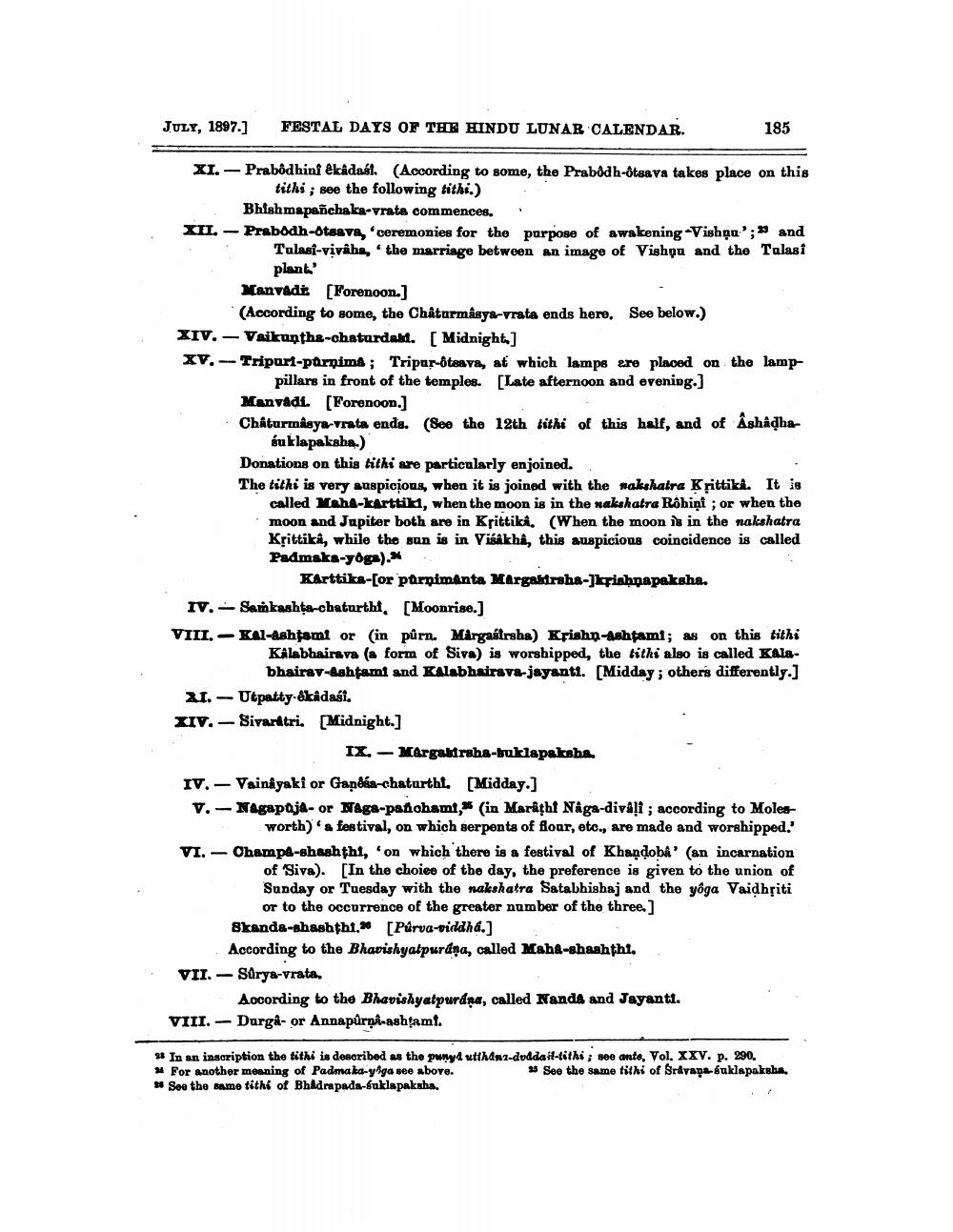________________
JULY, 1897.] FESTAL DAYS OF THE HINDU LUNAR CALENDAR.
XI. Prabodhinî êkâdast. (According to some, the Prabodh-ôtsava takes place on this
tithi; see the following tithi.)
Bhishmapañchaka-vrata commences.
XII.
XIV. - Vaikuntha-chaturdasi. [Midnight.]
-
- Prabodh-otsava, 'ceremonies for the purpose of awakening -Vishnu'; and Tulasi-vivaha, the marriage between an image of Vishnu and the Tulasi plant.'
Manvadi [Forenoon.]
(According to some, the Châturmasys-vrata ends here. See below.)
21. XIV.
XV. - Tripuri-parnima; Tripur-ôtsava, at which lamps are placed on the lamppillars in front of the temples. [Late afternoon and evening.] Manvadi. [Forenoon.]
VI.
Châturmasya-vrata ends. (See the 12th tithi of this half, and of Ashadha
fuklapaksha.)
Donations on this tithi are particularly enjoined.
IV. Samkashta-chaturthi, [Moonrise.]
VIII.
The tithi is very auspicious, when it is joined with the nakshatra Krittiki. It is
called Maha-karttiki, when the moon is in the nakshatra Rôhini; or when the moon and Jupiter both are in Krittiki. (When the moon is in the nakshatra Krittika, while the sun is in Visakha, this auspicious coincidence is called Padmaka-yoga).
Karttika-[or purnimânta Margasirsha-]krishnapaksha.
185
Kal-Ashtami or (in pûrn. Margastraha) Krishn-Ashtami; as on this tithi Kalabhairava (a form of Siva) is worshipped, the tithi also is called Kalabhairav-Ashtami and Kalabhairava-jayanti. [Midday; others differently.] Utpatty-êkâdaśî.
Sivaratri. [Midnight.]
IX.-Margaliraha-buklapaksha.
IV.
- Vainayaki or Ganesa-chaturthi. [Midday.]
V.
— Nagapůjå- or Naga-pañchami,* (in Marathi Naga-divâļi; according to Molesworth) 'a festival, on which serpents of flour, etc., are made and worshipped.' Champa-shashthi, 'on which there is a festival of Khandoba' (an incarnation
of 'Siva). [In the choice of the day, the preference is given to the union of Sunday or Tuesday with the nakshatra Satabhishaj and the yoga Vaidhriti or to the occurrence of the greater number of the three.] Skanda-shashthi. According to the Bhavishyatpurana, called Maha-shashthi.
[Pûrva-viddha.]
VII. Surya-vrata,
According to the Bhavishyatpurdṇa, called Nanda and Jayanti. VIII. - Durga- or Annapurṇa-ashtami.
28 In an inscription the tithi is described as the punya utthanz-dvddait-tithi; see ante, Vol. XXV. p. 290.
25 See the same tithi of Sravana-suklapaksha.
24 For another meaning of Padmaka-yoga see above.
* See the same tithi of Bhadrapada-suklapaksha.




